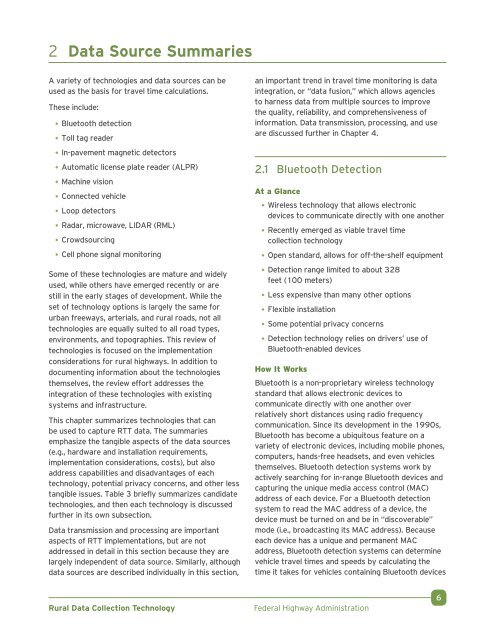Rural Data Collection Technology - FHWA Operations - U.S. ...
Rural Data Collection Technology - FHWA Operations - U.S. ...
Rural Data Collection Technology - FHWA Operations - U.S. ...
- No tags were found...
You also want an ePaper? Increase the reach of your titles
YUMPU automatically turns print PDFs into web optimized ePapers that Google loves.
2 <strong>Data</strong> Source SummariesA variety of technologies and data sources can beused as the basis for travel time calculations.These include:• Bluetooth detection• Toll tag reader• In-pavement magnetic detectors• Automatic license plate reader (ALPR)• Machine vision• Connected vehicle• Loop detectors• Radar, microwave, LIDAR (RML)• Crowdsourcing• Cell phone signal monitoringSome of these technologies are mature and widelyused, while others have emerged recently or arestill in the early stages of development. While theset of technology options is largely the same forurban freeways, arterials, and rural roads, not alltechnologies are equally suited to all road types,environments, and topographies. This review oftechnologies is focused on the implementationconsiderations for rural highways. In addition todocumenting information about the technologiesthemselves, the review effort addresses theintegration of these technologies with existingsystems and infrastructure.This chapter summarizes technologies that canbe used to capture RTT data. The summariesemphasize the tangible aspects of the data sources(e.g., hardware and installation requirements,implementation considerations, costs), but alsoaddress capabilities and disadvantages of eachtechnology, potential privacy concerns, and other lesstangible issues. Table 3 briefly summarizes candidatetechnologies, and then each technology is discussedfurther in its own subsection.<strong>Data</strong> transmission and processing are importantaspects of RTT implementations, but are notaddressed in detail in this section because they arelargely independent of data source. Similarly, althoughdata sources are described individually in this section,an important trend in travel time monitoring is dataintegration, or “data fusion,” which allows agenciesto harness data from multiple sources to improvethe quality, reliability, and comprehensiveness ofinformation. <strong>Data</strong> transmission, processing, and useare discussed further in Chapter 4.2.1 Bluetooth DetectionAt a Glance• Wireless technology that allows electronic .devices to communicate directly with one another• Recently emerged as viable travel time .collection technology• Open standard, allows for off-the-shelf equipment• Detection range limited to about 328feet (100 meters)• Less expensive than many other options• Flexible installation• Some potential privacy concerns• Detection technology relies on drivers’ use ofBluetooth-enabled devicesHow It WorksBluetooth is a non-proprietary wireless technologystandard that allows electronic devices tocommunicate directly with one another overrelatively short distances using radio frequencycommunication. Since its development in the 1990s,Bluetooth has become a ubiquitous feature on avariety of electronic devices, including mobile phones,computers, hands-free headsets, and even vehiclesthemselves. Bluetooth detection systems work byactively searching for in-range Bluetooth devices andcapturing the unique media access control (MAC)address of each device. For a Bluetooth detectionsystem to read the MAC address of a device, thedevice must be turned on and be in “discoverable”mode (i.e., broadcasting its MAC address). Becauseeach device has a unique and permanent MACaddress, Bluetooth detection systems can determinevehicle travel times and speeds by calculating thetime it takes for vehicles containing Bluetooth devices<strong>Rural</strong> <strong>Data</strong> <strong>Collection</strong> <strong>Technology</strong>Federal Highway Administration6
















